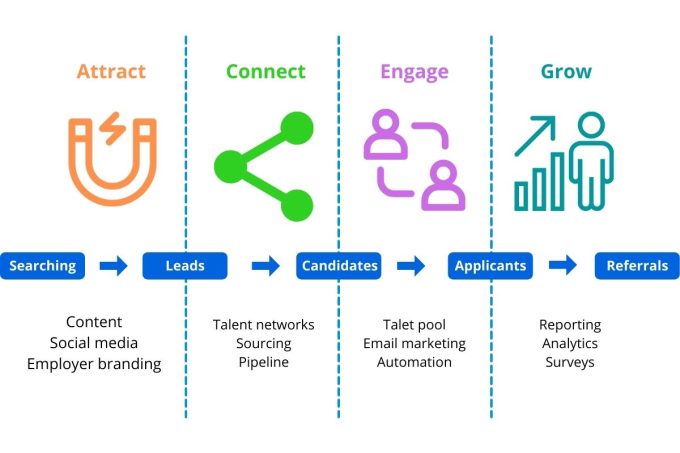5 essential automation tips for your HR processes
HR companies know better than anyone how difficult it is these days to recruit the right profile. Making matches between recruiters and employees is a craft, and the fact that the right profiles are increasingly hard to find, makes it even more of a challenge to complete this task successfully. It’s like trying to find the needle in the haystack.
Candidates are also more demanding than they used to be: they are looking for the perfect match, an interesting range of tasks, career opportunities, flexibility, you name it. As a recruiter, you want to maximize the amount of time you spend contacting candidates and customers to answer questions, convince people and to make the perfect match. Candidates will ultimately choose the most interesting employee experience.
Of course, there are also many other human resources processes that you would like to streamline as much as possible. As an HR company you can automate a lot to make both the employee journey and the candidate journey run smoothly. In this article we share these 5 essential automation tips for HR companies.
Your employee experience
Your own organization benefits from pursuing a great employee experience. When all stakeholders get together to build the best possible process together, there is buy-in from everyone and you are all working towards the same goal. Amazingly, a lot of organizations still fail to do this.
But there’s another reason to take a hard look at the entire employee experience. By analyzing and perfecting every step, you ensure smoother processes, more efficiency and a more positive experience for your own employees.
It also helps you spot potential bottlenecks:
- If the process is not standardized, you create more room for human error, and HR teams have to solve a lot more questions and problems manually.
- Your employees may start looking for workarounds and implement their own solutions, making it much harder to take over each other’s work in their absence.
- By using non-standardized processes you risk not being able to meet deadlines, or colleagues not complying with (legal) obligations.
A positive candidate journey
Just as customers go through a customer journey, so do candidates, but with a candidate journey. In fact, a candidate is a very specific type of buyer persona that also moves through a funnel. Only, the product here is a bit different: the candidate is selling their time and skills in exchange for a salary.
The matchmaking process that HR companies have to manage has not become any easier over time. There are more touch points than ever before. And on top of that, the demand for specific profiles far exceeds the amount of available profiles. Candidates prefer options that offer a good candidate experience, and rightly so. Automating the candidate journey does have some clear advantages:
- Faster and more efficient follow up of candidates. Speed is essential for successful recruitment.
- Less time spent on repetitive and administrative jobs, which you can reinvest in better matchmaking, networking and personal contacts.
- With all kinds of tools such as chatbots, integrations with Whatsapp, a modern and well-managed CRM system you can inform candidates through different channels in a personalized and automated way.
Applicants hate it when they don’t get any feedback after applying, or if it takes too long. Moreover, a lot of copy paste errors often creep into the communication. These are all experiences that result in a poor candidate journey. You can solve all of these issues by automating the process.


Monitoring and adjusting
As we mentioned earlier, one of the biggest pitfalls in automation is to just sit back and do nothing. Automation does mean that a number of things happen automatically, but it also means that any errors in your communication will multiply very quickly. Or that suboptimal communication will remain suboptimal for a very long time if you don’t regularly monitor and adjust your workflows.
HR processes are diverse and not always that simple. It is therefore a good idea to regularly scrutinize automated processes. If you don’t, you might miss out on opportunities to further optimize existing flows. These are also topics that deserve a place on the HR meeting agenda, since they often concern different colleagues on your team.
In addition, by monitoring well you can also map out which tasks are common or take up a lot of your team’s time. You can then automate specific tasks, in order to tighten up your processes and improve both your employee experience and your candidate journey.
Start small
Now don’t suddenly start automating entire processes from A to Z. We fully understand the eagerness with which companies often start doing this. But don’t get carried away in your enthusiasm to work out complex and all-encompassing workflows, it’s a recipe for disaster.
You need to start small. So instead of automating the entire HR process, why not start off simply by automating the first touch point in the onboarding process of new employees. This way you’re making it much more concrete and manageable. It allows you to quickly set something up and test things, without having to rework elaborate workflows. If it works well, you can build on that step by step, and optimize the complete process as you go along.
The iterative approach
Once you’ve picked an element to automate, you then get to work on it. We already gave it away: first work out that one element, test it, present it to colleagues and ask for feedback. Once that element has been optimized and the stakeholders are satisfied, you can move on to the next step.
This is what it could look like:
- You set up a new chatbot for job applicants
- Go for a simple flow with a minimum number of steps
- Test that flow with a small group of relevant users
- Gather feedback from them about their experience
- Process their feedback in the next version and test it again with a larger group
Don’t aim for the perfect workflow, it simply doesn’t exist. (At least we have never seen a perfect one ourselves). Just make sure to have a good working base and build on that, this will get you far.
Many HR companies dream about having fully automated processes. A lot is possible if you have clear goals and you approach it the right way. You should also keep in mind that change management with your stakeholders is equally important, if not more so, than the automation software you’re going to use. These 5 essential automation tips for your HR processes should help you well on your way.
Grow Significantly With Marketing Automation
Download our Ultimate Marketing Automation Guide and start growing your business today;






